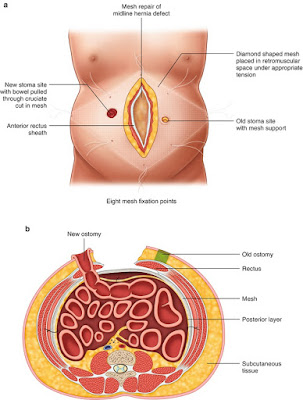Hernia
A hernia is a bizarre lump in the weakened part
of the abdominal wall. A protrusion appears near the bowel on the flat layers
of the belly muscles. In the case of ostomy patients, the muscles and the walls
around the stoma become sensitive and fragile; therefore, in this section, a
hernia can build up. In the initial symptoms, an ostomate only feels a bulging
part in the lower abdomen. A person realizes the protrusion around the opening
or hole in the belly wall. It takes time to become it large and noticeable
under clothes.
Parastomal Hernia
A hernia or lump around the opening in the
abdominal wall (stoma) is called a parastomal hernia. This disease does not
appear in every ostomate; however, 5 to 10 % of ostomy patients suffer from the
disease. Usually, colostomy people suffer most from the parastomal hernia.
However, only 3 to 9% of ileostomy patients suffer from parastomal hernia.
Moreover, this is not an ultimate measurement, every stoma patient can suffer
from this illness. Therefore, it is unpredictable and unsure to say about the
accurate percentage and reasons of the parastomal hernias. It may develop due
to any reason except colostomy or ileostomy in the ostomates.
Causes of the Parastomal Hernia
A hernia is one of the common problems in ostomy
patients. Every person has a different cause of a lump in the abdomen or near
the opening. A parastomal hernia can occur due to the following reasons:
Stoma in Rectus Abdominus
When a stoma or hole appears in the abdomen of
the patients, the whole muscles of the internal organs and abdomen get
disturbed. The entire system feels up and down due to the incision and an
artificial passage of the colon or ileum. The stoma occurs in the abdominal
muscles, called rectus abdominous. This area can lead to the stomal hernia
creation.
Obesity in Ostomy Patients
Obesity is another reason for the hernia
formation in ostomy persons. Many ostomates gain weight after the stoma
surgery, this can lead to the hernia. Moreover, some ostomates are already
obese; therefore, they develop a lump around the stomal wall. Patients with
normal weight do not suffer from the parastomal hernia or they develop fewer
chances of developing lump as compared to the fat people.
Poor Nutrition of Ostomates
Poor nutrition is another major reason for the
formation of a parastomal hernia. Most ostomy patients do not pay much
attention to their healthy diet after stoma creation. Moreover, many ostomates
even do not eat properly. Therefore, poor diet or malnutrition can lead to the
disturbance of rectus abdominal muscles. This can weaken the process of healing
of stoma, internal organs, and muscles around the opening; therefore, there is
a sky-high probability of parastomal hernia.
Age of the Ostomate
The age of the ostomy patient does matter a lot
in the case of parastomal hernia. If an ostomate is old, there are high risks
for the development of a lump in the abdominal wall. The muscles around the
stoma and belly become weaken with the age; therefore, such patients are
vulnerable to the parastomal hernia.
Increased Pressure in the Abdomen of Ostomate
Due to the increased intra-abdominal pressure, an
ostomate may develop a parastomal hernia. Due to chronic coughing, intense
sneezing, and lifting heavyweight, an ostomy person can lead to a parastomal
hernia. Such habits can weaken the muscles of the abdomen and around the stoma;
thus, a simple pressure on the internal muscles can create hernia in ostomates.
Infection in Stoma
After an ostomy surgery either colostomy or
ileostomy, many patients suffer from infection in the stomal or internal
organs. Due to carelessness, an ostomate's stitches and opening walls d not
heal on time; therefore, such patients develop a parastomal hernia.



No comments:
Post a Comment